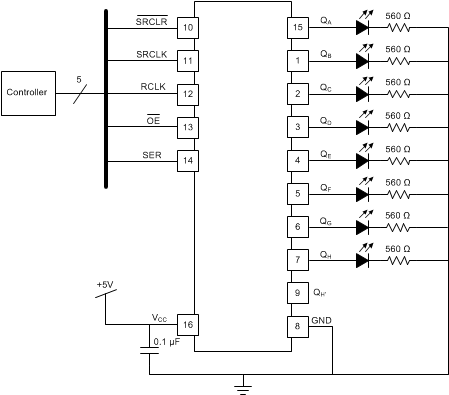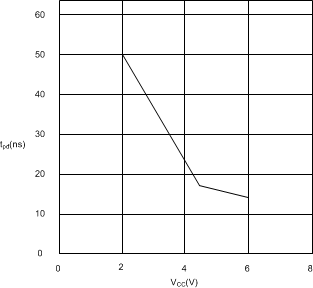SCLS751 March 2016 SN74HC595B
PRODUCTION DATA.
- 1 Features
- 2 Applications
- 3 Description
- 4 Pin Configuration and Functions
- 5 Specifications
- 6 Parameter Measurement Information
- 7 Detailed Description
- 8 Application and Implementation
- 9 Power Supply Recommendations
- 10Layout
- 11Device and Documentation Support
- 12Mechanical, Packaging, and Orderable Information
Package Options
Mechanical Data (Package|Pins)
- RWN|16
Thermal pad, mechanical data (Package|Pins)
Orderable Information
8 Application and Implementation
NOTE
Information in the following applications sections is not part of the TI component specification, and TI does not warrant its accuracy or completeness. TI’s customers are responsible for determining suitability of components for their purposes. Customers should validate and test their design implementation to confirm system functionality.
8.1 Application Information
The SN74HC595B is a low-drive CMOS device that is used for a multitude of bus interface type applications where output ringing is a concern. The low drive and slow edge rates will minimize overshoot and undershoot on the outputs. QH' pin of the first register should be connected to the serial (SER) pin of the second register for daisy chaining.
8.2 Typical Application
 Figure 5. Typical Application Schematic
Figure 5. Typical Application Schematic
8.2.1 Design Requirements
This device uses CMOS technology and has a balanced output drive. Take care to avoid bus contention because it can drive currents in excess of the maximum limits. The high drive will also create fast edges into light loads, so routing and load conditions should be considered to prevent ringing.
8.2.2 Detailed Design Procedure
- Recommended input conditions
- Specified high and low levels. See (VIH and VIL) in the Recommended Operating Conditions table.
- Specified high and low levels. See (VIH and VIL) in the Recommended Operating Conditions table.
- Inputs are over-voltage tolerant allowing them to go as high as 5.5 V at any valid VCC
- Recommended output conditions
- Load currents should not exceed 35 mA per output as per the Absolute Maximum Ratings table.
- Outputs should not be pulled below Ground or above VCC
8.2.3 Application Curves
 Figure 6. SN75HC595B tpd vs. VCC
Figure 6. SN75HC595B tpd vs. VCC